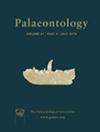尖峰虫多节Hou的腹侧组织及其对巨唇鱼头部分割的意义
IF 2.3
2区 地球科学
Q1 PALEONTOLOGY
引用次数: 2
摘要
巨头动物,或大附肢真节肢动物,在关于全类群真节肢动物头部区域早期进化的讨论中占有突出地位。然而,由于与化石压缩相关的数据丢失,加上其中一些分类群的稀有性,大多数代表的腹侧形态的几个方面仍然不完全清楚。本文利用显微计算机断层成像技术对剑锋棘多节棘头的腹侧结构进行了描述,并探讨了其进化意义。头部由一对有柄的眼睛,一对巨大的附属物和四对著名的附属物组成,所有附属物都被背部的头部盾牌覆盖。头部的吻侧部分有一个中间突起,我们将其解释为与在其他寒武纪真节肢动物中观察到的类似的前巩膜。多节蕨的前巩膜有关节,茎粗壮,在较近的位置有圆形突起,并有复眼。至关重要的是,多节棘猴头部的腹侧具有一个突出的叶状假设体/唇状复合体,位于大附属物的后面,位于第一对著名的附属物之间。这种情况与在Leanchoilia illecebrosa中观察到的情况一致,并表明Megacheira有一个保守的、可能是祖先的六节头(眼睛、大附属物和四个著名的肢体附属物)和一个假设体/唇状复合体的模式。多节假体/唇状复合体的存在否定了剑锋纲头部前突可能与真节肢动物唇状同源的假设。本文章由计算机程序翻译,如有差异,请以英文原文为准。
Ventral organization of Jianfengia multisegmentalis Hou, and its implications for the head segmentation of megacheirans
Megacheirans, or great‐appendage euarthropods, have featured prominently in discussions regarding the early evolution of the head region in total‐group Euarthropoda. However, several aspects of the ventral morphology of most representatives remain incompletely known given the loss of data associated with fossil compression, coupled with the rarity of some of these taxa. Here, we describe the ventral aspect of head organization of the jianfengiid megacheiran Jianfengia multisegmentalis using micro computed‐tomography, and explore its evolutionary significance. The head consists of a pair of stalked eyes, a pair of great appendages, and four pairs of biramous appendages, all covered by a dorsal head shield. The rostral portion of the head bears a median projection, which we interpret as an anterior sclerite akin to that observed in several other Cambrian euarthropods. The anterior sclerite in J. multisegmentalis articulates with robust stalks with rounded projections in a more adaxial position, and bears the compound eyes. Critically, the ventral side of the head of J. multisegmentalis features a prominent lobe‐shaped hypostome/labrum complex located immediately behind the great appendages, and between the first pair of biramous appendages. This situation is consistent with that observed in Leanchoilia illecebrosa and suggests a conserved, and possibly ancestral, pattern of a six‐segmented head (eyes, great appendages and four biramous limb appendages) with a hypostome/labrum complex for Megacheira. The existence of the hypostome/labrum complex in J. multisegmentalis falsifies the hypothesis that the anterior projections on the head of jianfengiids might be homologues of the euarthropod labrum.
求助全文
通过发布文献求助,成功后即可免费获取论文全文。
去求助
来源期刊

Palaeontology
地学-古生物学
CiteScore
5.60
自引率
3.80%
发文量
43
审稿时长
6 months
期刊介绍:
Palaeontology publishes a wide variety of papers on palaeontological topics covering:
palaeozoology
palaeobotany
systematic studies
palaeoecology
micropalaeontology
palaeobiogeography
functional morphology
stratigraphy
taxonomy
taphonomy
palaeoenvironmental reconstruction
palaeoclimate analysis and biomineralization studies.
 求助内容:
求助内容: 应助结果提醒方式:
应助结果提醒方式:


